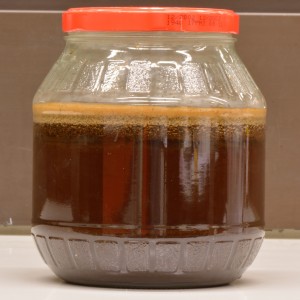Blog
Science is in everyday life – illustrated on the example of cold extraction of coffee
There is this perception, most often seen in movies, that science is something only conducted in dedicated laboratories solely by highly trained professionals (or crazy people, especially if it’s a horror movie).
However, natural science is simply finding patterns in nature leading to reproducible results.
This doesn’t have to be done by a highly trained scientist. Indeed, the empirical modern scientific method in the early days was modeled by the Royal Society after the English justice system of the time, where verdicts were announced by a jury consisting of people with no legal training. The idea was that the facts themselves were something obvious that could be agreed upon by everyone, regardless of profession, experience or training. Only the interpretation would require a judge or scientist with the knowledge to understand the significance of these facts within the law or the scientific theories.
But even if you do happen to be a scientist by profession, don’t forget: Science doesn’t suddenly stop applying once you clock off at the end of the day. The patterns of nature are still there, and they’re not restricted to the parts you’re investigating during your workday. For example, if you’re investigating solutes transported in the human body at work, does it stop being science if you investigate solutes transported from coffee grounds to the water at home?
Conversely, if science is in everyday life, you can apply science to everyday life. As could be guessed from the title, I have applied my scientific knowledge to making coffee and will now use it to illustrate my point.
Background
The original protocol for our lab saw to the use of a French press. It is not really suited for making only a single cup of coffee, as such a small volume is difficult to properly mix and filter. So if just one person wants to drink coffee, they still have to make more than just one cup, and if no one else happens to want a cup at the same time, the only thing they can do with the leftover is to pour it into a thermos jug to keep the coffee warm in case someone wants to drink some later. By that time, however, the coffee has usually become stale and ends up being dumped. This is where I got the initial idea for using cold extraction.
The thing is, staling is the result of a whole bunch of chemical reactions that proceed faster at higher temperatures and slower at lower temperatures. So, naturally, with the freshly brewed hot coffee, there wouldn’t be much time until all those reactions have proceeded to turn the tasty compounds into less tasty compounds. If we were now to cool the coffee down on the other hand, it would last longer – and that’s the basic idea of a fridge. However, first heating the coffee up for the extraction, then putting it in the fridge to cool down and then reheat it again to drink is not only a large waste of energy, but the coffee will also be warm for quite some time. During this time, the staling process can still proceed quickly.
Methodology
Now here’s the big question that ultimately led to the cold-brew coffee: Why heat the coffee for the extraction? After all, extraction is also a process that proceeds faster at higher temperatures and slower at lower temperatures, but it doesn’t actually stop. Therefore, you can simply compensate a lower temperature with more time.
All of this is basic high school chemistry. I didn’t have to get a degree in chemistry for that. And that’s the lesson I’d like to impart at this point: Remember what knowledge you have and realize it may apply to the situation at hand. This can be all kind of knowledge: Long buried general education, hobbies, random television documentaries, small talk with colleagues, superficially unrelated skills, newspaper articles – there’s a whole human behind the scientist, one who knows a lot more than just his or her specific field of expertise.
Reapplying that lesson to the coffee-making, what did the scientific education teach me? Do a literature research! After all, the concept of a low temperature extraction is pretty obvious and straightforward, so it’s pretty much guaranteed that others have come up with it before. A quick Internet search with the keywords “coffee cold extraction” revealed that already back in the Age of Sail, Dutch traders were using it, and it’s been popular enough that there’s a developed coffee culture, with plenty of publicly posted opinions on the proper way of making cold-brewed coffee we can mine for knowledge.
And quite differing opinions they are. Whether it’s the coffee-water-ratio, the extraction time or the filtering method – it’s just like with every other method of coffee brewing. So what to do? Here’s my next advice: If you’re trying to follow a recipe, try to understand what each step actually contributes. This holds true just as much for cooking as it does for following a protocol for chemical synthesis. Sure, if it’s a good recipe, you can follow it blindly and have a good chance to succeed. But if you happen to fail, you won’t be able to recognize where it went wrong. The other thing you’ll miss is flexibility. If you know exactly what a particular step does, you can replace it with another one achieving the same result. Did I really need to buy a specially designed drip brewer for cold brew coffee? A drip brewer simply separates the spent coffee grounds from the coffee, something our French press could do as well. Yes, the filtration method would make a small difference, but there’s no need to buy expensive specialized equipment before even testing the main concept.
Still, it’s very helpful to have a recipe. For example, I knew the extraction would take longer, but how much longer? There’s this very rough rule of thumb that a 10 K temperature difference changes the reaction rate by a factor of 2. But depending on the numbers used for temperature and extraction time, the formula can give anything between 9 and 17 h. So it was very helpful to get more precise number from a recipe, 12 h in this case.
And some things you just may not think of. For example, cold brew coffee is usually made with a higher ratio of coffee grounds to water and then used as a concentrate, to be diluted later on with hot water when drinking. So, yes, do think about recipes and protocols critically, but don’t forget that whoever wrote the recipe should have had more experience and may know something you don’t.
Results
Of course, if you change part of a recipe, it will no longer be optimized. So even if the first attempt isn’t an immediate success, as long as it isn’t completely terrible, it can still be a worthwhile pursuit. You’ll just have to find the new parameters that match the new recipe. This is where the experimenting starts, trying out different substrate-solvent ratios, extraction times, separation methods. Even if some combinations don’t work out, you’ll still gain a better understanding of the various steps and how they influence the final result. The important thing here is to keep good notes. What’s the point of making the ideal cup of coffee if you can’t do it again?
And since I followed this advice, I can report here on my recipe, which is ideally suited for people who don’t want to spend much money on equipment. Otherwise, it’s not fundamentally different from the majority of the recipes you can find on the Internet.
1. Buy good beans.
There’s no way around that one: You can’t extract something that isn’t there. I’m not going to recommend a specific brand, because I’m not being paid for any advertising and because it’s a matter of personal taste anyway. That said, if you’re not happy with your coffee, try different beans. It can make a world of a difference, and you can’t improve something without changing something.
2. For 1 l of coffee: Take 120 g of ground coffee and put them into 2.5 dl water in a sealable glass container, stir well.
I know I’m not being very specific here about the grinding of the coffee, even though the proper particle size has a large influence on the end result due to the different surface-to-volume ratios. I’ll write more about the whys and hows of grinding coffee in the second blog entry on this topic, including yet another method for people unwilling to spend money on dedicated equipment.
3. CO2 trapped in the grounds will make them float to the top, and create foam which will trap the grounds on the surface. Since these aren’t properly immersed in the water, their contents won’t be extracted properly, so you’ll have to stir again after roughly 15 min and once more after an additional 45 min. Add another 5 dl of water.
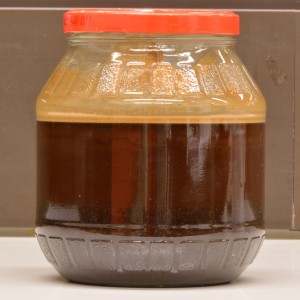
Coffee after 30 min. Most grounds have settled to the bottom, with only a few floating on the surface. None are trapped in the foam.
4. Keep the coffee protected from sunlight to extract. The exact time varies depending on the particle size of the grounds and personal preferences. In my experience, anything between 10 – 16 h has proven to work fine. The rule of thumb mentioned earlier happened to be quite accurate in this case.
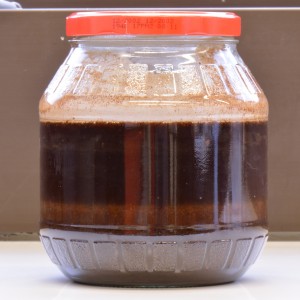
Coffee after 16 h. Even the finest coffee grounds have settled to the bottom, visible as a fine layer on top of the coarser grounds.
5. As the grounds are now at the bottom, the coffee can be separated by carefully decanting it into another vessel. Some larger grounds will usually be floating on the surface; you can get rid of these by decanting through a regular kitchen sieve if you want.
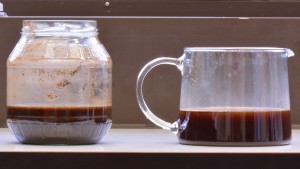
Coffee after decanting into a teapot. No kitchen sieve was used here and the geometry of the extraction chamber shown is not very well suited for decanting, so many grounds ended up in the teapot.
Usually, quite a lot of grounds will still be in the coffee after the first decantation, so decant a second time.
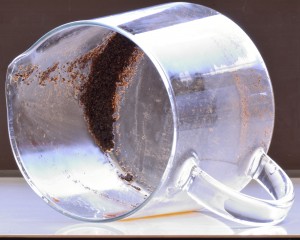
Leftover grounds after the second decantation. It’s no big deal if the first decantation isn’t very clean; the second one will get rid of most grounds.
6. You should have now roughly 5 dl of cold brew coffee concentrate that you can use immediately or pour into a glass bottle to keep in the fridge for up to a week. If you want to drink a cup, mix the concentrate 1:1 with hot water. If that’s too cold for your taste, you can heat it up further in a microwave. Enjoy!

